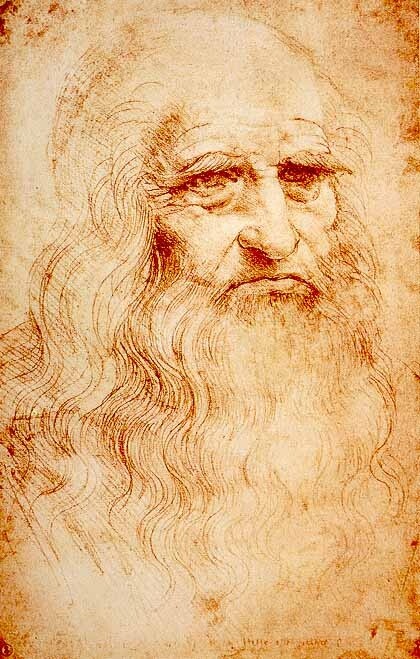 Self-Portrait of Leonardo, 1510-1515, sanguine, Turin, Biblioteca Reale, inv. no. 15571.
Self-Portrait of Leonardo, 1510-1515, sanguine, Turin, Biblioteca Reale, inv. no. 15571.
Who was Leonardo da Vinci?
Leonardo di ser Piero da Vinci, born on April 15, 1452, and passing away on May 2, 1519, was a remarkable figure of the High Renaissance in Italy. He was not only a painter but also a versatile polymath, engaging in various fields such as engineering, science, sculpture, architecture, and more. Although initially renowned for his artistic prowess, his collection of notebooks containing drawings and notes on diverse subjects like anatomy, astronomy, botany, cartography, painting, and paleontology also contributed to his fame. Leonardo is widely regarded as a genius who embodied the ideals of Renaissance humanism, and his works continue to inspire generations of artists, second only to his contemporary, Michelangelo.
Born to a successful notary and a woman from a lower social class, Leonardo grew up in or near Vinci, and he received his education in Florence under the guidance of the renowned Italian painter and sculptor, Andrea del Verrocchio. He commenced his career in Florence but later served Ludovico Sforza in Milan, spending a significant amount of time there. He subsequently worked in Florence and Milan again, briefly visiting Rome, attracting numerous imitators and students along the way. In the final years of his life, upon the invitation of Francis I, Leonardo resided in France until his demise in 1519. Since then, his achievements, diverse interests, personal life, and empirical thinking have continued to captivate and garner admiration, making him a recurring theme in cultural references.
Leonardo is widely recognized as one of the greatest painters in art history and is often hailed as the initiator of the High Renaissance movement. Despite many of his works being lost and fewer than 25 major works being attributed to him (including several unfinished pieces), he created some of the most influential paintings in Western art. His masterpiece, the Mona Lisa, stands as his most renowned work and is often considered the world's most famous painting. The Last Supper, a religious painting, holds the record for being the most reproduced of its kind. Additionally, his drawing of Vitruvian Man has become a cultural icon. In 2017, Salvator Mundi, a painting partially attributed to Leonardo, was sold for a record-breaking $450.3 million in a public auction, becoming the most expensive painting ever sold.
Apart from his accomplishments in the realm of art, Leonardo is revered for his technological ingenuity. He envisioned flying machines, armored vehicles, concentrated solar power, and a ratio machine applicable to an adding machine. However, only a few of his designs were realized or feasible during his lifetime, as the scientific understanding of metallurgy and engineering was still in its early stages during the Renaissance. Some of his smaller inventions, such as an automated bobbin winder and a wire tensile strength testing machine, made their way into manufacturing without much recognition. Leonardo made significant discoveries in various fields including anatomy, civil engineering, hydrodynamics, geology, optics, and tribology. However, he did not publish his findings, and their direct impact on subsequent scientific advancements was minimal.
In summary, Leonardo da Vinci was a multifaceted genius of the High Renaissance era, celebrated for his artistic talent, scientific inquiries, and technological innovations. His enduring legacy and impact on multiple disciplines continue to inspire and captivate the world.
 Leonardo da Vinci, Saint John the Baptist, 1513–1516. Oil on walnut wood, 69 cm × 57 cm. Louvre Abu Dhabi, Abu Dhabi.
Leonardo da Vinci, Saint John the Baptist, 1513–1516. Oil on walnut wood, 69 cm × 57 cm. Louvre Abu Dhabi, Abu Dhabi.
Paintings of the 1500s
In 1505, Leonardo received a commission to paint The Battle of Anghiari in the Salone dei Cinquecento (Hall of the Five Hundred) located in the Palazzo Vecchio in Florence. His composition depicted a dynamic scene with four men on fierce war horses engaged in a battle over a standard, representing the Battle of Anghiari in 1440. Michelangelo was assigned the opposite wall to paint the Battle of Cascina. Unfortunately, Leonardo's painting deteriorated rapidly and is now only known from a copy created by Rubens.
One of Leonardo's notable works from the 16th century is the Mona Lisa, also known as La Gioconda or the laughing one. It is arguably the most famous painting in the world today. The painting's fame is largely due to the elusive smile on the woman's face, which has a mysterious quality attributed to the subtly shadowed corners of her mouth and eyes, making it difficult to determine the exact nature of the smile. This shadowy quality, which became known as "sfumato" or Leonardo's smoke, adds to the painting's renowned charm. Vasari, a contemporary art historian, described the smile as "so pleasing that it seems more divine than human, and it was considered a wondrous thing that it was as lively as the smile of the living original."
Other notable features of the painting include the simple attire, which allows the eyes and hands of the subject to stand out without distractions, the dramatic landscape background that conveys a sense of movement and change, the subdued coloring, and the exceptionally smooth technique of the brushwork. Leonardo applied oil paint in a manner similar to tempera, creating a blended surface where individual brushstrokes are indistinguishable. Vasari remarked that the quality of the painting would cause even the most confident master to "despair and lose heart." The painting's remarkable state of preservation without any signs of repair or overpainting is rare for a panel painting of its age.
In the painting Virgin and Child with Saint Anne, Leonardo once again explored the theme of figures within a landscape. This composition, described as "breathtakingly beautiful" by Wasserman, features two figures placed at oblique angles. Mary is seated on the lap of her mother, Saint Anne, and she leans forward to gently restrain the playful Christ Child with a lamb, symbolizing his future sacrifice. This painting, copied numerous times, had a significant influence on artists such as Michelangelo, Raphael, Andrea del Sarto, Pontormo, and Correggio. The compositional trends seen in this artwork were particularly embraced by Venetian painters like Tintoretto and Veronese.
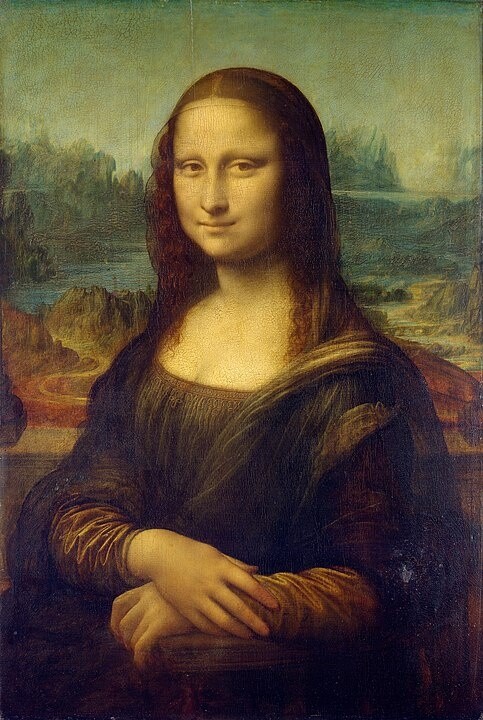 Leonardo da Vinci, Mona Lisa, c. 1503–1506. Oil on poplar panel, 77 cm × 53 cm. Paris: Louvre Museum.
Leonardo da Vinci, Mona Lisa, c. 1503–1506. Oil on poplar panel, 77 cm × 53 cm. Paris: Louvre Museum.
Mona Lisa
The Mona Lisa strikingly resembles Renaissance representations of the Virgin Mary, which was considered an ideal of femininity at the time. The woman in the painting is seated upright in a "pozzetto" armchair with her arms folded, indicating a reserved posture. Her gaze is fixed on the viewer. Leonardo used his technique of not using visible outlines, known as sfumato. This soft fusion of colors creates an ambiguous atmosphere, particularly evident in the corners of the mouth and eyes.
The way the sitter is portrayed in the Mona Lisa, positioned in a three-quarter profile, shares similarities with works from the late 15th century by artists such as Lorenzo di Credi and Agnolo di Domenico del Mazziere. Art historian Zöllner points out that the overall pose of the sitter can be traced back to Flemish models, particularly noting the presence of vertical columns on both sides of the panel, a characteristic seen in Flemish portraiture. Woods-Marsden references Hans Memling's portrait of Benedetto Portinari (1487) and Italian imitations like Sebastiano Mainardi's pendant portraits as examples where a loggia is used. This architectural element serves to connect the sitter with the distant landscape, a feature not present in Leonardo's earlier portrait of Ginevra de' Benci.
The Mona Lisa stands out as one of the earliest portraits to feature the subject positioned in front of a fictional landscape, and Leonardo was among the pioneering artists to employ aerial perspective. The enigmatic woman is depicted seated in what appears to be an open loggia, characterized by dark pillars on either side. Behind her, a vast landscape unfolds, stretching towards icy mountains. In this landscape, we can discern winding paths and a distant bridge, subtly hinting at human presence. Leonardo made a deliberate choice to position the horizon line not at the level of the sitter's neck, as he did in the case of Ginevra de' Benci, but aligned with her eyes. This artistic decision links the figure intimately with the surrounding landscape and enhances the painting's air of mystery. Silvano Vincenti identified the bridge in the background as the Romito Bridge, an ancient four-arched structure from Etruscan-Roman times near Laterina, Arezzo, spanning the Arno River. Other bridges with similar arches suggested as possible locations featured more arches in their design.
The Mona Lisa does not display clearly visible eyebrows or eyelashes, although Vasari provides a detailed description of the eyebrows. In 2007, French engineer Pascal Cotte revealed findings from his ultra-high resolution scans of the painting, indicating that the original portrayal of the Mona Lisa did indeed include eyelashes and eyebrows. However, over time, these features gradually disappeared, possibly due to excessive cleaning. Cotte's scans also unveiled that the painting underwent multiple alterations, including changes to the size of the face and the direction of the sitter's gaze. Additionally, he discovered that a layer of the painting depicted the subject wearing numerous hairpins and a headdress adorned with pearls, which were later eradicated and covered with subsequent layers of paint.

Who is the subject of the Mona Lisa?
According to tradition, the Mona Lisa is believed to portray Lisa Gherardini, commonly referred to as "Monna" Lisa, which is a diminutive form of "Madonna." The name "Monna Lisa" originates from the Latin phrase "Mea domina," which translates to "my lady." Lisa Gherardini was the wife of Francesco del Giocondo, hence the association of her with the painting. During Leonardo's third stay in Florence, he resided in a house owned by a branch of the Gherardini di Montagliari family, which was situated near Piazza della Signoria in a now-destroyed building on Via de' Gondi.
The identification of Lisa Gherardini as the model for the Mona Lisa can be traced back to ancient sources, including a document from 1525 listing paintings found among the possessions of Gian Giacomo Caprotti, known as "Salaì," who was a pupil of Leonardo and accompanied him to France. In this document, the painting is first mentioned as "la Joconda." Giorgio Vasari, a renowned artist and writer, also mentioned the portrait in his writings, stating that Leonardo created it for Francesco del Giocondo, adding that after four years of work, Leonardo left it unfinished. Vasari notes that the painting was then in the possession of King Francis of France in Fontainebleau. However, Vasari's description of the painting mentioning details such as beautifully painted eyebrows and dimples on the cheeks has raised some doubts, as the Mona Lisa does not possess these features. These inconsistencies can be explained by the painting's complex history, as it underwent modifications and restorations by Leonardo himself over many years. Vasari might have based his description on the version of the painting he saw in Florence until 1508, when Leonardo left the city. X-ray analysis has revealed the existence of three hidden versions of the Mona Lisa beneath the current one.
In support of Vasari's account, in 2005, historian Veit Probst, director of the Heidelberg Library in Germany, published a note written by the Florentine chancellor Agostino Vespucci in 1503. The note confirms the existence of a portrait of Lisa del Giocondo by Leonardo da Vinci, comparing Leonardo to the renowned ancient Greek painter Apelles. The note mentions Lisa del Giocondo as well as another figure, Anna, the mother of the Virgin Mary, being portrayed by Leonardo. The note further references Leonardo's plans for the great council chamber, as he had recently signed an agreement with the Gonfaloniere. The note is dated October 1503.
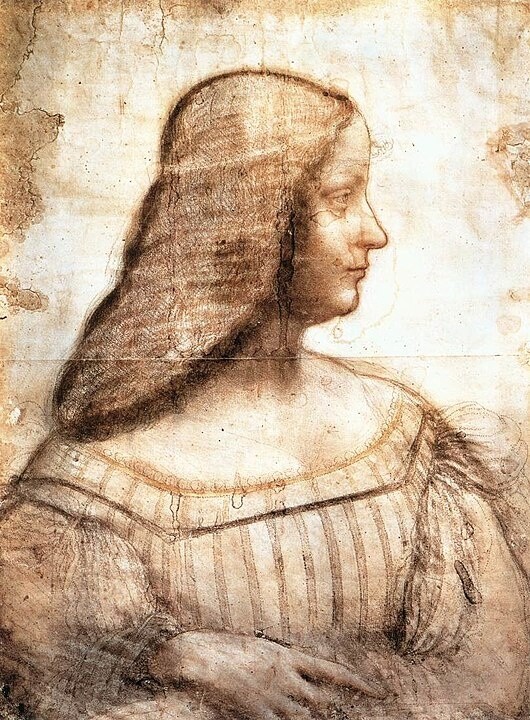 Portrait of Isabella d'Este (Leonardo), 1499-1500.
Portrait of Isabella d'Este (Leonardo), 1499-1500.
Isabella d’Este
According to the current comprehensive catalog of Leonardo da Vinci's works (2018), Isabella d'Este is the only documented alternative candidate for the identity of the Mona Lisa.
Isabella d'Este (1474-1539) was the Marchesa of Mantua and a renowned patroness of the arts during her time. Leonardo da Vinci served as the court painter to her sister, Beatrice d'Este, in the Duchy of Milan. In 1499, after the Sforza family was expelled from power, Leonardo sought refuge at the court of Isabella d'Este. During his three-month stay there, Leonardo created several drawings of Isabella, as mentioned in various letters. One such drawing, a profile portrait, is currently held at the Louvre Museum and bears visual resemblances to the Mona Lisa.
There are known letters from the years 1501 to 1506 in which Isabella, both directly and through intermediaries, requested Leonardo to fulfill his promise of painting her portrait in oil.The timing of these letters coincides with the period in which the Mona Lisa is believed to have been created.
The reservations expressed by the Louvre Museum pertain to the apparent blond hair depicted in Isabella d'Este's portraits. However, other portraits of Isabella, such as the Ambras miniature and the portrait of Isabella in Red, depict her with brown hair and a resemblance to her likeness. The only exception to this is the portrait of Isabella in black, where she is portrayed as blonde. Despite these arguments, the identification of Isabella d'Este as the sitter of the Mona Lisa remains controversial outside the confines of the museum's own documentation, primarily because the head in the painting lacks both idealized beauty and similarities to the aforementioned portraits.
Other identifications
Additional suggestions for the identity of the Mona Lisa have included Caterina Sforza, who was historically proposed as a possible candidate, as well as Leonardo's own mother, Caterina Buti del Vacca. Isabella of Aragon, the Duchess of Milan in 1489, has also been considered a potential subject, as she advised Leonardo to incorporate the halo of the magic square of the sun into his painting of the Last Supper. Some have speculated that the noblewoman depicted could be a member of the Imperial family. Others have traced her identity to Bianca Giovanna Sforza, the legitimate eldest daughter of Ludovico il Moro, who held the titles of Lady of Bobbio and Voghera. Alternatively, there are suggestions linking her to Pacifica Brandani, the mistress of Duke Giuliano de' Medici.
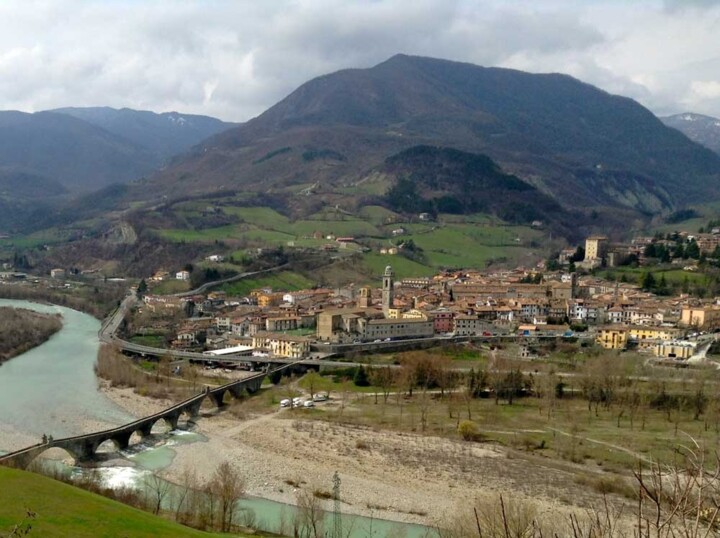 Bobbio, an Italian municipality in the province of Piacenza, in the Trebbia Valley, Emilia-Romagna.
Bobbio, an Italian municipality in the province of Piacenza, in the Trebbia Valley, Emilia-Romagna.
What is the place in the background of the Mona Lisa?
Each day, an average of 30,000 visitors enter the Louvre in Paris to catch a glimpse of the famous painting by Leonardo Da Vinci, commonly known as the Mona Lisa or La Gioconda. Despite its modest size, the Mona Lisa has always captivated immense attention. Over time, countless individuals have pondered the identity of the woman portrayed by Da Vinci, the meaning behind her enigmatic expression, and the landscape depicted in the painting. Recent scientific studies suggest that the village portrayed in the background of the Mona Lisa is likely Bobbio. According to researcher Carla Glori, who proposed this theory in 2015, subsequent studies and analyses have reinforced her claim regarding the Bobbio background in Leonardo da Vinci's artwork.
Confirmation of this hypothesis has emerged through the findings of a group of scientists who discovered evidence of Leonardo da Vinci's presence in the vicinity of Pierfrancesco di Gropparello, near Bobbio, during the early 1500s when the renowned painting was created. Led by Andrea Baucon from the University of Genoa and Gerolamo Lo Russo from the Natural History Museum of Piacenza, the group examined ichnofossils, which are fossilized traces of past living beings' footprints. The area near Bobbio had already been recognized as having geological significance for Leonardo da Vinci. This recent discovery was published in the specialized geology journal Rips.
Bobbio is situated on the left bank of the river that shares its name and owes its prominence to its strategic location at the foot of Monte Penice. It has become a prominent center in Val Trebbia, Emilia-Romagna. With its ancient Abbey, founded in 614 by the Irish monk San Colombano, Bobbio has been known since ancient times. During the Middle Ages, the monastery thrived, leading to the town acquiring the status of a city in 1014. Presently, the small village in the province of Piacenza maintains its medieval structure with its narrow streets, charming stone houses, and majestic palaces, earning recognition as one of the most beautiful villages in Italy.
History of the masterpiece
Among Leonardo da Vinci's body of work, the Mona Lisa is the only portrait that has never faced significant doubts about its authenticity. In fact, it is one of only four works, along with Saint Jerome in the Wilderness, Adoration of the Magi, and The Last Supper, that have remained free from attribution controversies. Leonardo began working on a portrait of Lisa del Giocondo, the model for the Mona Lisa, around October 1503. Some believe that the painting was initiated in 1503 or 1504 in Florence. While the Louvre Museum states that it was likely painted between 1503 and 1506, art historian Martin Kemp acknowledges the challenges in establishing precise dates with certainty.Alessandro Vezzosi suggests that the painting exhibits characteristics of Leonardo's style in his later years, post-1513. Other scholars argue that, based on historical documentation, Leonardo would have painted the work after 1513. According to Vasari, Leonardo worked on the painting for four years before leaving it unfinished. In 1516, Leonardo was invited by King Francis I to work at the Clos Lucé near the Château d'Amboise, and it is believed that he brought the Mona Lisa with him and continued to work on it after relocating to France. Art historian Carmen C. Bambach has concluded that Leonardo probably made refinements to the painting until 1516 or 1517. Leonardo experienced paralysis in his right hand around 1517, which may explain why he left the Mona Lisa incomplete.
Around the year 1505, Raphael created a sketch using pen and ink, which prominently features the columns flanking the subject. This sketch is widely accepted to be based on Leonardo's portrait of the Mona Lisa. Additionally, there are other later copies of the Mona Lisa, found in institutions such as the National Museum of Art, Architecture and Design, and The Walters Art Museum, that also exhibit large columns on the sides. This led to the belief that the Mona Lisa painting had been trimmed. However, in 1993, Frank Zöllner observed that the surface of the painting had never been trimmed, and this observation was confirmed through tests conducted in 2004. Based on this, Vincent Delieuvin, the curator of 16th-century Italian painting at the Louvre, suggests that the sketch and the other copies were likely inspired by a different version of the Mona Lisa. Zöllner further proposes that the sketch may be based on another portrait of the same subject by Leonardo.
According to records from October 1517, it was stated that the Mona Lisa was created for the deceased Giuliano de' Medici, who served as Leonardo's steward at Belvedere in Vienna between 1513 and 1516. However, this is likely an error. Vasari, on the other hand, claims that the painting was commissioned by Francesco del Giocondo, the model's husband. Some experts argue that Leonardo actually produced two versions of the painting. This is due to the uncertainty surrounding its date, commissioner, and fate after Leonardo's death in 1519, as well as the differences found in Raphael's sketch, which could be explained by the possibility that he sketched it from memory. The first hypothetical portrait, featuring prominent columns, would have been commissioned by Giocondo around 1503 and remained unfinished in the possession of Leonardo's pupil and assistant, Salaì, until Salaì's death in 1524. The second version, commissioned by Giuliano de' Medici around 1513, would have been sold by Salaì to Francis I in 1518 and is the one currently displayed in the Louvre. Others argue that there was only one genuine Mona Lisa but are divided on the two aforementioned scenarios regarding its fate. At some point during the 16th century, a varnish was applied to the painting. It was initially housed at the Palace of Fontainebleau before being transferred to the Palace of Versailles by Louis XIV, where it remained until the French Revolution. In 1797, it found its permanent home on display at the Louvre.
 Blank space on the wall of the Louvre following the 1911 theft.
Blank space on the wall of the Louvre following the 1911 theft.
The theft
After the French Revolution, the Mona Lisa was relocated to the Louvre, but it briefly resided in Napoleon's bedroom at the Tuileries Palace. At that time, the painting was not widely known outside the art world. However, in the 1860s, it began to gain recognition among the French intelligentsia as a masterpiece of Renaissance art. During the Franco-Prussian War, the painting was moved from the Louvre to the Brest Arsenal for protection.
In 1911, the Mona Lisa was still not popular among the general public. However, on August 21, 1911, the painting was stolen from the Louvre. The theft was discovered the following day by painter Louis Béroud. Suspicion fell on poet Guillaume Apollinaire and his friend Pablo Picasso, but they were later cleared of any involvement. The actual thief was a Louvre employee named Vincenzo Peruggia, who believed the painting should be returned to Italy. Peruggia kept the Mona Lisa in his apartment for two years before attempting to sell it. He was caught when he approached the director of the Uffizi Gallery in Florence. The painting was exhibited in the Uffizi Gallery before being returned to the Louvre in 1914. Peruggia served a prison sentence for the theft. The story of the theft gained further intrigue when a journalist named Karl Decker published an account in 1932, claiming to have met a supposed accomplice named Eduardo de Valfierno.
During World War II, the painting was moved multiple times for its protection. It was taken to various locations, including the Château d'Amboise, the Loc-Dieu Abbey, the Château de Chambord, and finally the Ingres Museum in Montauban.
In 1956, a man named Ugo Ungaza Villegas threw a rock at the Mona Lisa, causing minor damage. In 1974, a woman sprayed red paint on the painting during its display at the Tokyo National Museum. In 2009, a Russian woman threw a ceramic teacup at the painting. Fortunately, in both cases, the painting remained unharmed. To prevent further attacks, bulletproof glass was installed to protect the artwork.
In recent decades, the painting has been temporarily relocated on three occasions to accommodate renovations at the Louvre. In 1992-1995, 2001-2005, and 2019, the painting was moved to ensure its safety during the restoration work. A new queuing system was introduced in 2019 to reduce waiting times for visitors to see the painting. Each group now has a limited time of about 30 seconds to view the artwork.
On May 29, 2022, an activist disguised as a woman in a wheelchair threw cake at the protective glass covering the painting, apparently as a protest to raise awareness for climate change. Fortunately, the painting was not damaged. The individual was arrested and placed in psychiatric care, and an investigation was initiated following a complaint filed by the Louvre.
All the Mona Lisas of art history
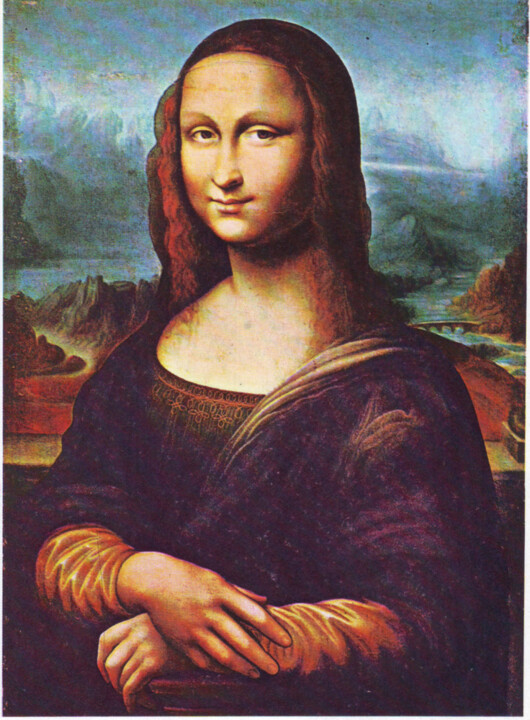 Copy of Mona Lisa commonly attributed to Salaì.
Copy of Mona Lisa commonly attributed to Salaì.
 The Prado Museum La Gioconda.
The Prado Museum La Gioconda.
Prado Museum La Gioconda
A version of the Mona Lisa known as "Mujer de mano de Leonardo Abince" (Woman by Leonardo da Vinci's hand) housed in the Museo del Prado in Madrid was initially believed to be a work by Leonardo himself for many centuries. However, after undergoing restoration in 2012, it is now believed to have been created by one of Leonardo's pupils in his studio around the same time as the original Mona Lisa was being painted. The Prado Museum's conclusion that the painting was likely the work of Salaì (1480-1524) or Melzi (1493-1572) has been challenged by others who hold different opinions.
The restored painting presents a slightly different perspective compared to the original Mona Lisa, leading to speculation that it may have been intended as part of the world's first stereoscopic pair. However, a more recent report has shown that this supposed stereoscopic effect does not provide reliable depth perception.
 The Isleworth Mona Lisa.
The Isleworth Mona Lisa.
Isleworth Mona Lisa
An alternative version of the Mona Lisa, known as the Isleworth Mona Lisa, was acquired by an English nobleman in 1778 and later rediscovered in 1913 by Hugh Blaker, an art enthusiast. The Mona Lisa Foundation unveiled this painting to the public in 2012. It depicts the same subject as Leonardo da Vinci's Mona Lisa. However, there is no clear consensus among scholars regarding its attribution. Some experts, including Frank Zöllner, Martin Kemp, and Luke Syson, have denied that it was painted by Leonardo. On the other hand, professors such as Salvatore Lorusso, Andrea Natali, and John F Asmus have supported the attribution. Some, like Alessandro Vezzosi and Carlo Pedretti, remain uncertain.
 Hermitage Mona Lisa.
Hermitage Mona Lisa.
Hermitage Mona Lisa
The Hermitage Museum houses a version of the Mona Lisa known as the Hermitage Mona Lisa. This particular rendition of the painting was created by an unidentified artist from the 16th century.
Mona Lisa key concepts
The Mona Lisa, also known as Gioconda in Italian or Joconde in French, is a famous half-length portrait painted by the Italian artist Leonardo da Vinci.
Regarded as a quintessential masterpiece of the Italian Renaissance, it is widely recognized as "the most famous, most visited, most written about, most sung about, and most parodied work of art in the world." The painting's uniqueness lies in several aspects, including the enigmatic expression of the subject, the grandeur of its composition, the subtle rendering of forms, and the illusionistic atmosphere it creates.
The identity of the person depicted in the painting has been definitively established as Lisa del Giocondo, an Italian noblewoman. It was executed using oil paint on a panel made of white Lombardy poplar. Although Leonardo never presented the painting to the Giocondo family, it is believed that he mentioned it in his will and intended it for his favored apprentice Salaì. While it was initially thought to have been painted between 1503 and 1506, recent research suggests that Leonardo may have continued working on it as late as 1517. The painting was eventually acquired by King Francis I of France and has been the property of the French Republic since then. It has been on permanent display at the Louvre Museum in Paris since 1797.
The global fame and popularity of the Mona Lisa can be traced back to its theft in 1911 by Vincenzo Peruggia, who justified his actions as an act of Italian patriotism, believing that the painting should belong to Italy. The theft and subsequent recovery in 1914 garnered unprecedented attention and publicity for an art heist. It inspired various cultural depictions, including the opera Mona Lisa in 1915, two early 1930s films titled The Theft of the Mona Lisa and Arsène Lupin, and the iconic song "Mona Lisa" recorded by Nat King Cole, which became one of the most successful songs of the 1950s.
In terms of value, the Mona Lisa is one of the most valuable paintings in the world. It holds the Guinness World Record for the highest known insurance valuation in history, which was $100 million in 1962, equivalent to $1 billion in 2023.

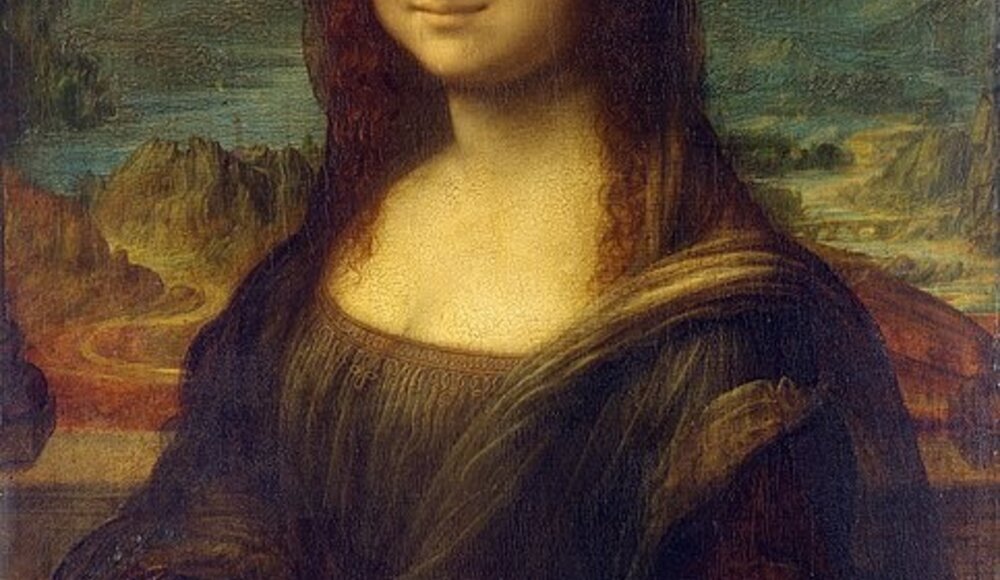
 Selena Mattei
Selena Mattei